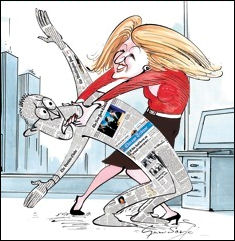In a 3.31 New Yorker piece called “Out of Print: The Death and Life of the American Newspaper,” Eric Alterman notes that in a recent episode of The Simpsons, “a cartoon version of Dan Rather introduced a debate panel featuring ‘Ron Lehar, a print journalist from the Washington Post.’ This inspired Bart’s nemesis Nelson to shout, ‘Haw haw! Your medium is dying!’ “‘Nelson!’ Principal Skinner admonished. “But it is!” came the young man’s reply.

IlIustration by Gerald Scarfe
“Nelson is right,” Alterman writes. “Newspapers are dying; the evidence of diminishment in economic vitality, editorial quality, depth, personnel, and the over-all number of papers is everywhere. What this portends for the future is complicated.” But Alter comes up with a tight and sobering assessment later in the piece.
“We are about to enter a fractured, chaotic world of news, characterized by superior community conversation but a decidedly diminished level of first-rate journalism,” he says. “The transformation of newspapers from enterprises devoted to objective reporting to a cluster of communities, each engaged in its own kind of ‘news’ — and each with its own set of ‘truths’ upon which to base debate and discussion — will mean the loss of a single national narrative and agreed-upon set of ‘facts’ by which to conduct our politics.
News, in short, “will become increasingly ‘red’ or ‘blue.’ This is not utterly new. Before Adolph Ochs took over the N.Y. Times, in 1896, and issued his famous ‘without fear or favor’ declaration, the American scene was dominated by brazenly partisan newspapers. And the news cultures of many European nations long ago embraced the notion of competing narratives for different political communities, with individual newspapers reflecting the views of each faction. It may not be entirely coincidental that these nations enjoy a level of political engagement that dwarfs that of the United States.”
Arianna Huffington, co-founder and editor-in-chief of the Huffington Post (which just surpassed the Drudge Report in readership), tells Alterman that the online and the print newspaper model are beginning to converge: “As advertising dollars continue to move online — as they slowly but certainly are — HuffPost will be adding more and more reporting and the Times and Post model will continue with the kinds of reporting they do, but they’ll do more of it originally online.”
She predicts “more vigorous reporting in the future that will include distributed journalism — wisdom-of-the-crowd reporting of the kind that was responsible for the exposing of the Attorneys General firing scandal.” As for what may be lost in this transition, she is untroubled: “A lot of reporting now is just piling on the conventional wisdom — with important stories dying on the front page of the New York Times.”
